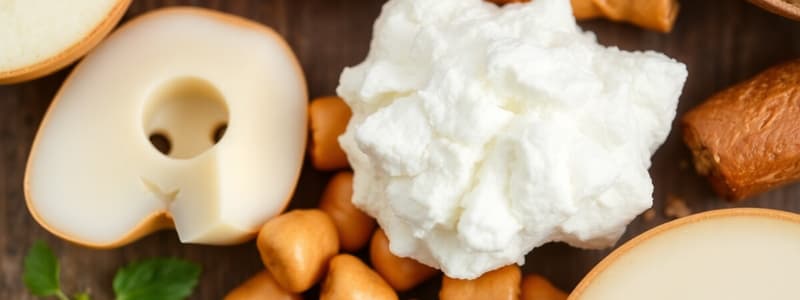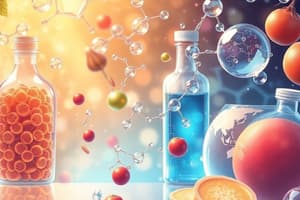Podcast
Questions and Answers
Which of the following polysaccharides is composed of unbranched chains of glucose units linked by β-1,4-glycosidic bonds?
Which of the following polysaccharides is composed of unbranched chains of glucose units linked by β-1,4-glycosidic bonds?
- Glycogen
- Amylopectin
- Cellulose (correct)
- Starch
Amylose is a branched polymer of α-D-glucose molecules.
Amylose is a branched polymer of α-D-glucose molecules.
False (B)
What type of bond links the glucose monomers in glycogen?
What type of bond links the glucose monomers in glycogen?
α-1,4-glycosidic bonds and α-1,6-glycosidic bonds
Humans can easily digest starch due to the presence of _____ bonds between glucose molecules.
Humans can easily digest starch due to the presence of _____ bonds between glucose molecules.
Match the following terms with their characteristics:
Match the following terms with their characteristics:
Which of the following disaccharides contains a β-1,4-glycosidic bond?
Which of the following disaccharides contains a β-1,4-glycosidic bond?
Sucrose is a reducing sugar.
Sucrose is a reducing sugar.
What is the primary source of sucrose?
What is the primary source of sucrose?
Lactose is formed by combining ______ and ______.
Lactose is formed by combining ______ and ______.
Which type of sugar is fructose classified as based on sweetness?
Which type of sugar is fructose classified as based on sweetness?
Match the following carbohydrates with their classification:
Match the following carbohydrates with their classification:
Name the reaction process that produces alditols from D-glucose.
Name the reaction process that produces alditols from D-glucose.
Polysaccharides are formed by the condensation of monosaccharides with the removal of n-1 molecules of water.
Polysaccharides are formed by the condensation of monosaccharides with the removal of n-1 molecules of water.
Which of the following is NOT a function of carbohydrates?
Which of the following is NOT a function of carbohydrates?
Isomerism involves compounds that have different molecular formulas.
Isomerism involves compounds that have different molecular formulas.
What is the molecular formula for glucose?
What is the molecular formula for glucose?
Carbohydrates are composed of carbon, hydrogen, and ______.
Carbohydrates are composed of carbon, hydrogen, and ______.
Match the type of isomerism with its description:
Match the type of isomerism with its description:
Which statement about L-Glucose is correct?
Which statement about L-Glucose is correct?
D and L isomerism is a type of structural isomerism.
D and L isomerism is a type of structural isomerism.
What type of carbohydrate-related isomerism allows for the formation of stereoisomers?
What type of carbohydrate-related isomerism allows for the formation of stereoisomers?
What type of monosaccharide is D-Glucose classified as?
What type of monosaccharide is D-Glucose classified as?
D-Fructose is an aldohexose.
D-Fructose is an aldohexose.
What is the common blood glucose level range in mg/dL?
What is the common blood glucose level range in mg/dL?
Maltose is composed of two ______ molecules.
Maltose is composed of two ______ molecules.
Match the following disaccharides with their components:
Match the following disaccharides with their components:
Which of the following statements is true regarding Maltose?
Which of the following statements is true regarding Maltose?
The glycosidic linkage in sucrose involves the carbonyl groups of both sugars.
The glycosidic linkage in sucrose involves the carbonyl groups of both sugars.
Name the structure used to represent cyclic forms of monosaccharides.
Name the structure used to represent cyclic forms of monosaccharides.
Which of the following monosaccharides is an epimer at C-2?
Which of the following monosaccharides is an epimer at C-2?
Epimers are monosaccharides that differ from each other in configuration around more than one carbon atom.
Epimers are monosaccharides that differ from each other in configuration around more than one carbon atom.
What are the two types of optical isomers based on the direction they rotate plane polarized light?
What are the two types of optical isomers based on the direction they rotate plane polarized light?
The change in the specific optical rotation caused by the interconversion of α and β forms of a monosaccharide is referred to as ______.
The change in the specific optical rotation caused by the interconversion of α and β forms of a monosaccharide is referred to as ______.
Match the following terms with their descriptions:
Match the following terms with their descriptions:
Which of the following is a characteristic of aldoses?
Which of the following is a characteristic of aldoses?
Anomers are isomers that differ in the position of hydroxyl groups on carbon atoms other than the anomeric carbon.
Anomers are isomers that differ in the position of hydroxyl groups on carbon atoms other than the anomeric carbon.
Name one example of a monosaccharide that can exist in α and β forms.
Name one example of a monosaccharide that can exist in α and β forms.
Flashcards
What are carbohydrates?
What are carbohydrates?
A major source of energy in our diet that is composed of carbon, hydrogen, and oxygen.
What other name is used for carbohydrates?
What other name is used for carbohydrates?
Carbohydrates are also known as saccharides, which means 'sugars'.
How do plants make carbohydrates?
How do plants make carbohydrates?
Plants produce carbohydrates through photosynthesis, using carbon dioxide, water, and sunlight.
What happens to carbohydrates in our bodies?
What happens to carbohydrates in our bodies?
Signup and view all the flashcards
What are isomers?
What are isomers?
Signup and view all the flashcards
What are structural isomers?
What are structural isomers?
Signup and view all the flashcards
What are stereoisomers?
What are stereoisomers?
Signup and view all the flashcards
What are enantiomers?
What are enantiomers?
Signup and view all the flashcards
Optical Activity
Optical Activity
Signup and view all the flashcards
Dextrorotatory
Dextrorotatory
Signup and view all the flashcards
Levorotatory
Levorotatory
Signup and view all the flashcards
Epimers
Epimers
Signup and view all the flashcards
Anomers
Anomers
Signup and view all the flashcards
Mutarotation
Mutarotation
Signup and view all the flashcards
Monosaccharides
Monosaccharides
Signup and view all the flashcards
Aldose
Aldose
Signup and view all the flashcards
Aldohexose
Aldohexose
Signup and view all the flashcards
Ketopentose
Ketopentose
Signup and view all the flashcards
D-Glucose
D-Glucose
Signup and view all the flashcards
D-Fructose
D-Fructose
Signup and view all the flashcards
D-Galactose
D-Galactose
Signup and view all the flashcards
Dissacharide
Dissacharide
Signup and view all the flashcards
Homopolysaccharide
Homopolysaccharide
Signup and view all the flashcards
Heteropolysaccharide
Heteropolysaccharide
Signup and view all the flashcards
Glycogen
Glycogen
Signup and view all the flashcards
Cellulose
Cellulose
Signup and view all the flashcards
Sucrose
Sucrose
Signup and view all the flashcards
Reducing Sugars
Reducing Sugars
Signup and view all the flashcards
Non-reducing Sugars
Non-reducing Sugars
Signup and view all the flashcards
Reduction of Carbohydrates
Reduction of Carbohydrates
Signup and view all the flashcards
Starches
Starches
Signup and view all the flashcards
Study Notes
Carbohydrates
- Major source of energy in our diet
- Composed of the elements carbon (C), hydrogen (H), and oxygen (O)
- Also called saccharides, meaning "sugars"
- Produced by photosynthesis in plants, such as glucose, using CO2, H2O, and energy from the sun
- Oxidized (respiration) in living cells to produce CO2, H2O, and energy
- "Hydrate of carbon"
- Derived from the formula Cn(H2O)m
- Glucose: C6H12O6 or C6(H2O)6
- Polyhydroxy aldehydes, polyhydroxy ketones, or compounds that yield them after hydrolysis
Function
- Provides energy
- Glycogen provides short-term energy reserves
- Supplies carbon for the synthesis of other biochemical substances
- Part of the structure of DNA and RNA
- Linked to lipids in cell membranes
- Linked to proteins in biological recognition processes
- Regulates blood sugar
- Spares protein use for energy
- Breaks down fatty acids and prevents ketosis
- Provides flavor and sweeteners
- Source of dietary fiber
Isomerism
- Isomers are compounds with identical molecular formulas but different structures
- Types of isomerism:
- Structural isomerism (different arrangement of atoms)
- Stereoisomerism (same arrangement of atoms but different spatial arrangement)
- Types of stereoisomerism associated with glucose are D and L isomerism, Optical isomerism, Epimerism, a and β anomerism
- Enantiomers: Stereoisomers whose molecules are nonsuperimposable mirror images of each other
- Diastereomers: Stereoisomers whose molecules are not mirror images of each other
D and L Isomerism
- D-glucose is right-handed
- L-glucose is left-handed
Optical Isomerism
- Optical activity is the capacity of a substance to rotate the plane-polarized light passing through it
- Clockwise direction: Dextrorotatory (d) or (+)
- Counterclockwise direction: Levorotatory (l) or (-)
- Chiral compounds rotate polarized light clockwise or counterclockwise through a certain angle.
Epimerism
- If two monosaccharides differ in their configuration around a single specific carbon (other than the anomeric carbon) atom.
Anomerism
- Isomers formed by the change of position of a hydroxyl group attached to the anomeric carbon (e.g., α and β glucose are anomers)
- Also α and β fructose are anomers
Mutarotation
- Change in the specific optical rotation by interconversion of α and β forms of D-glucose to an equilibrium mixture.
Classification (by size)
- Monosaccharides: The simplest carbohydrates
- Disaccharides: Consist of 2 monosaccharides
- Oligosaccharides: Consist of 3-10 monosaccharides
- Polysaccharides: Contain many monosaccharides
Monosaccharide
- Consist of 3 to 6 carbon atoms, typically
- A carbonyl group (aldehyde or ketone)
- Several hydroxyl groups
- Colorless, crystalline solids
Aldose
- Monosaccharides with an aldehyde group
- Types include triose (3 carbon atoms), tetrose (4 carbon atoms), pentose (5 carbon atoms), hexose (6 carbon atoms)
- Examples: Erythrose (aldo-tetrose)
Ketose
- Monosaccharides with a ketone group
- Types include triose, tetrose, pentose, hexose
- Example: Fructose (ketohexose)
Important Monosaccharides
- D-Glucose: Found in fruits, corn syrup, and honey; known as blood sugar.
- D-Fructose: Sweetest carbohydrate, found in fruits, juices and honey.
- D-Galactose: Found in lactose, a disaccharide.
Important Disaccharides
- Maltose: Malt sugar; composed of two glucose molecules; from starch hydrolysis.
- Lactose: Found in milk and milk products; comprised of glucose and galactose.
- Sucrose: Table sugar; obtained from sugar cane and sugar beets; composed of glucose and fructose.
Relative Sweetness
- Fructose is sweeter than sucrose.
- Lactose has little sweetness.
Classification (by reaction)
- Reducing sugars: React positively with Benedict's and Tollen's test
- Examples: Lactose and Maltose
- Non-reducing sugars: React negatively with Benedict's and Tollen's test
- Examples: Sucrose
Reducing Sugars
- Carbohydrates with carbonyl group that oxidizes to a carboxylic acid
- Undergo reaction with Benedict's reagent (Cu2+) to give the corresponding carboxylic acid.
- Examples include Glucose, Galactose, Fructose
Oxidation of D-Glucose
- Glucose is oxidized to a carboxylic acid.
Reduction of D-Glucose
- Involves the carbonyl group and produces sugar alcohols (alditols)
- Example: D-glucose produces D-glucitol (sorbitol)
Polysaccharides
- Formed by the condensation of multiple monosaccharides with the removal of water molecules.
- Polysaccharides are non-reducing
- Types include:
- Homopolysaccharides (one type of monosaccharide monomer unit)
- Heteropolysaccharides (more than one, usually two, types of monosaccharide monomer units)
- Branched polysaccharides
- Unbranched polysaccharides
- Examples:
- Amylose and amylopectin (starches)
- Glycogen (animal starch)
- Cellulose
Amylose
- Polymer of α-D-glucose
- Linked by α-1,4 glycosidic bonds
- Unbranched chain
Amylopectin
- Polymer of α-D glucose
- Linked by a-1,4 glycosidic bonds
- Highly branched chain
Glycogen
- Polysaccharide that stores α-D-glucose in muscle.
- Similar to amylopectin but more highly branched.
Cellulose
- Polysaccharide of glucose units in unbranched chains
- Has β-1,4-glycosidic bonds
- Cannot be digested by humans
Fischer Projection
- Developed by Hermann Emil Fischer (German)
- Used to represent carbohydrates
- Places the most oxidized group at the top
- Shows chiral carbons as the intersection of vertical and horizontal lines
Studying That Suits You
Use AI to generate personalized quizzes and flashcards to suit your learning preferences.



